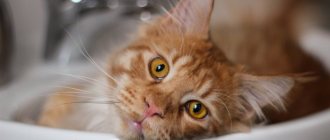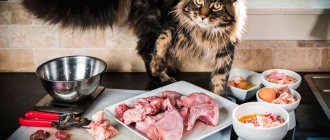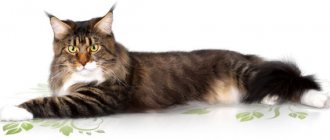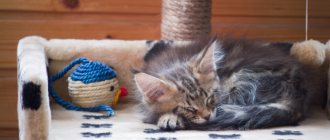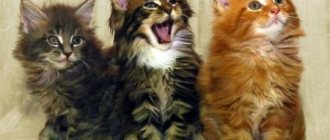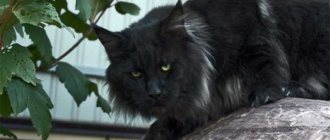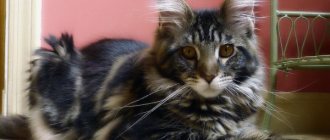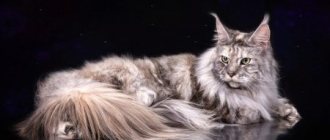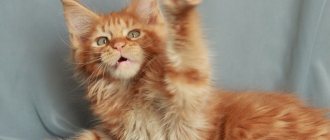Washing features
The fluffiness and length of the Maine Coon's tail is the pride and problem of the owners of the breed. You can keep the area representative clean by bathing. So that the cat is not afraid of the procedure, it needs to be taught to it from an early age.
It is better to bathe a small pet in a small container. Before manipulation, the Maine Coon kitten's fur and tail should be thoroughly combed.
The basin is filled with liquid. You need to add the selected product to cleanse your hair. Experts advise using baby shampoo or cat product. You need to put something at the bottom of the container to prevent it from slipping.
© shutterstock
The ears of a representative of the Maine Coon breed should be carefully plugged with cotton balls, and the animal’s head should not be wet. Detergents must be washed off carefully. The owner must ensure that the shampoo does not remain on the pet’s skin and hair. Care must also be taken when selecting a product for cleaning wool. Its composition gives the appearance of a cat.
Maine Coons should be bathed regularly. As the kitten matures, the small container becomes small. The manipulation will have to be performed in the bathroom. It is necessary to close the door so that the pet does not jump out and run away.
To minimize stress, use a mug to rinse them. The water should reach the cat's knees. Only the body should be washed. The owner must ensure that water does not get into the pet’s ears, nose and eyes.
You need to dry the animal with a towel or hair dryer. Frequent washing is not recommended. If the owner plans to send a representative of the Maine Coon breed to an exhibition, it is worth bathing him 8 days in advance for the event. A photo of a Maine Coon cat's tail will give you an idea of what a healthy animal should look like.
The appearance of bald spots
Sometimes a Maine Coon can lose its luxurious six. There are known cases of the formation of bald spots. If your Maine Coon has a loose tail, experts advise starting to eliminate the problem by identifying the cause of its occurrence.
Changes often occur due to poor nutrition. The animal's body may lack essential substances. With proper nutrition, hair loss indicates that the necessary substances are not absorbed by the pet’s body.
If hair loss occurs, you should contact your veterinarian. An expert will help identify the cause of the problem.
A representative of the Maine Coon breed can peel off due to the fault of the owner. Faced with the problem of excess fat in the area, owners strive to restore their pet’s former luster by any means necessary. There are cases where people tried to get rid of the problem by using dishwashing detergent. The result of such manipulation was loss of hair in the area. A similar effect can be observed when using inappropriate shampoos or other cosmetics. You should also not comb your cat after washing.
Care
Representatives of the Maine Coon breed require careful care. It is imperative to trim the hair under the tail. If you leave long hairs, dirt and fecal particles will accumulate on them. The Maine Coon will not look very good.
The area itself also needs treatment. To reduce the oiliness of the coat, the area is treated with starch or baby powder. To clean your pet's fur, gently rub the product into the area and leave for 2 minutes. When the period is over, the product is carefully removed from the wool.
© shutterstock
There is an alternative way to take care of the tail. Before washing, greasy areas are treated with a special paste. Then the breed representative is bathed and the product is thoroughly washed off.
An important part of care is feeding. For a Maine Coon to have a fox tail, the animal must eat well. Vitamins should be included in his diet. Due to a violation of mineral metabolism, a curled tail may form in a Maine Coon cat. Its presence may become an obstacle to obtaining a title at exhibitions. This problem does not correspond to the description of the breed. A hook on the tail of Maine Coons can also appear as a result of injury. Therefore, you need to treat your pet carefully.
Characteristic habits of Maine Coons
The Maine Coon even has a different character from an ordinary cat. Compared to a purebred pet, an “American” is more active, affectionate, friendly, and attached to its owner. He is flexible and understanding, and is not inclined to show aggression towards people.
Characteristics and habits of a purebred cat:
- the requirement to have your own corner in the house;
- recognition of only one person in the family as the owner;
- patient and friendly attitude towards children;
- love of water and water procedures;
- cleanliness;
- a tendency to indulge in self-indulgence, trickery, and active games;
- intellectual development, the ability to remember the owner's commands.
There are many cases of fraud when selling Maine Coons, so it is better to buy a kitten at an exhibition, or entrust the choice to a felinologist - a professional who knows the anatomical and physiological characteristics of cats of different breeds.
Also, when buying a pet, you need to ask the breeder for a document confirming the pedigree; it is issued only to purebred individuals. If she is not purebred, then she will only have a veterinary passport.
Source
Greasy wool: how to deal with it?
Animals have sebaceous glands. Discharge from them leads to a deterioration in the appearance of the coat. This phenomenon is common in unneutered cats, regardless of whether they were purchased from a cattery or purchased elsewhere. Females may have excess fat, but this is rare . Greasey fur in the area is eliminated during castration.
The greasy tail of the Maine Coon cat requires special care. Regular cleansing of the skin and coat improves the condition of the pet. To treat Maine Coon problem areas, you can use:
- degreasing pastes;
- special shampoos;
- baby powder;
- starch.
When choosing a product to normalize a Maine Coon's fat tail, you need to consult a specialist. It is better not to use shampoos for humans and other unnatural products not intended for cats.
Special characteristics of the breed
The Maine Coon breed is distinguished by several characteristic, pronounced features that are not found in ordinary cats:
- Tassels on the ears, like a lynx. They usually appear by three months of age. If the tassels have not formed by 4 months, then most likely they will no longer exist.
- Wide, high-set ears. They stand upright, there is no tilt towards the head. The distance between the ears corresponds to the width of the ear at the base. In adult cats, this figure may increase. Thick horizontal hairs grow on the inside of the auricle - peculiar brushes that perform the heating function.
- A serious, menacing look thanks to large, slightly slanted, almond-shaped eyes.
- The profile has a square shape. While a simple cat’s muzzle is neatly rounded.
- Large tail covered with long hair. In Maine Coon kittens, the tail easily reaches the shoulder blades, in some individuals it reaches the neck. The length of adult cats is 55-60 cm.
- Stiff and long mustache that feels like a fishing line. Their length reaches 18 cm. The whiskers of outbred cats are much softer.
The listed features are most pronounced in adult Maine Coon cats. However, by 3 months they are clearly visible in kittens. Experienced breeders still do not sell younger babies.
What to consider when choosing a kitten.
A real, purebred Maine Coon kitten is not cheap, and therefore it is worth taking the choice seriously, so as not to be deceived and not to buy a crossbreed, there is a lot to consider.
It is best, of course, to take a pet from professionals with documents and a contract, but even if you decide to take a kitten simply from the hands of amateurs, then you should do the following:
- Draw up a contract and print it out;
- Ask the seller to sign the contract;
- Look at the kitten's parents;
- Define metrics;
- Examine the kitten for signs of disease;
- A true Maine Coon is not shy or aggressive;
- A Maine Coon kitten at 4 months is 5 times larger than a regular kitten!
- A true purebred Maine Coon has thick, long, dense and fluffy fur;
- They have a wide, long nose with a large jaw;
- The tail of a purebred Maine Coon is always longer than the spine;
- Maine Coons are very calm, they never climb into corners, under sofas or hide.
Important: A cross with another breed will be very noticeable by 4 months, so you should not adopt a kitten earlier.
X-ray diagnosis of tail development abnormalities in dogs and cats
1. The tail is in its usual non-standard position. More often, this state of the tail can be seen in a calm, domestic state of the animal. At an exhibition, it is quite difficult to see a cat’s tail thrown over its back like a husky’s. We observed such a case, and in a state of emotional excitement, the cat’s tail became normal. Sphynxes love to curl their tail into a spiral and press it to their warm side or, sitting in a piggy bank, wrap it around their paws and hide the tip inside. Such a tail easily straightens and occupies a standard physiological position, in which no deformations are detected. Thus, this deformation is not anatomical, but physiological, which makes it possible for the expert not to reduce exhibition ratings and titles.
2. “Nervous” tail. In an excited state (“show stress”), the tip of the tail appears rigidly tense and slightly bent. In a calm or distracted state, normal flexibility returns to the tail and it straightens completely. There are no bone knots or other fixed deformities. The exhibition rating is not reduced.
3. Asymmetry of the last, rudimentary vertebra - both in the form of a nail and in the form of a crooked awl does not result in a reduction in show scores. In a lion, by the way, the tip of the tail is covered with keratinized skin, turning into a tail claw, which can cause serious damage when struck.
4. A short, blunt-ended tail without the characteristic reduced end vertebrae raises a reasonable suspicion of cosmetic correction of any defects. Now veterinary specialists have begun to practice cosmetic surgeries to correct tail defects, cryptorchidism, hernial openings and other anomalies. Properly carried out, they do not leave scars: many operations on cats pass without a trace. In the absence of a postoperative scar, a reduction in score is possible only for a shortened tail. Veterinary documents confirming the absence of surgical interventions are not taken into account.
5. Tail with a “pouch”. Excess skin at the end of the tail, the so-called “pouch,” is not related to bone deformities, but raises suspicions about the removal of a defective vertebra without proper correction of the skin residue. At the same time, it can arise on its own. Veterinary cosmetology may be in line with the spirit of the times, but the dishonesty of a certain part of the breeders who use “corrected” animals in breeding does not allow them to take its successes into service and recommend cosmetic operations on the tail to owners of animals with minor deformities of the terminal caudal vertebrae, no matter how positive the cosmetic this did not achieve any effect.
Choosing a name for a kitten.
Many people find it very difficult to choose a name for a kitten, or one that is too long in the pedigree or simply doesn’t like it. It is worth paying attention that it is best to choose a name for the baby, paying attention to the external characteristics, color, and behavior of the little Maine Coon.
Important: No matter how cute and small your pet is, do not call him with very gentle, diminutive nicknames like “Muska”, “Kroshka”, “Small”. Or ridiculous nicknames - “Pig”, “Red”, “Crow”, etc. Remember that the pet will grow up, become big and will visit exhibitions, a veterinarian, matings and a beautiful, suitable name will become an adornment for a chic Maine Coon .
Love and care.
Every creature on the planet loves and appreciates affection and attention; Maine Coon kittens are like children, they want warmth and care, but you can’t pamper them too much. Just don’t forget that severity and cruelty are two different things, but the best advisor is justice!
Maine Coons are a semi-long-haired cat breed bred in America. They owe their popularity to their large size, bright appearance and gentle character. The main distinguishing feature of the breed is its bushy tail. Its size can be equal to the length of the cat's body. In order for the Maine Coon's tail to maintain its beauty, it must be carefully looked after.
Documentation
Even if all the external signs and character of the kitten indicate that it absolutely belongs to the Maine Coon breed, you should not rush into the purchase. The terms of the transaction play an important role. A conscientious, responsible breeder will never hand over a kitten to a buyer without the appropriate documents:
- An agreement that will necessarily specify the age of the kitten, its external characteristics, the timing of its transfer to the new owner, and whether it has age-appropriate vaccinations and medical examinations.
- Veterinary passports with marks on the medical procedures completed.
- Pedigree. The document contains information about the baby’s parents and other information confirming his origin and belonging to the Maine Coon breed. Also in the pedigree there is a mark indicating that he is enrolled in one of three groups - Show, Breed or Pet.
Representatives of the first group have excellent exhibition characteristics. Breed cats have a good genotype and are suitable for professional breeding work. Pets from the Pet group are suitable for breeders who do not plan to travel with a cat to exhibitions or breed animals.
How to distinguish a Maine Coon kitten from a regular one is a common question among novice breeders. Before purchasing, you need to be well prepared, study the external characteristics of the breed, as well as the habits of large cats. Then the probability of getting a purebred kitten will approach 100%.
Source
